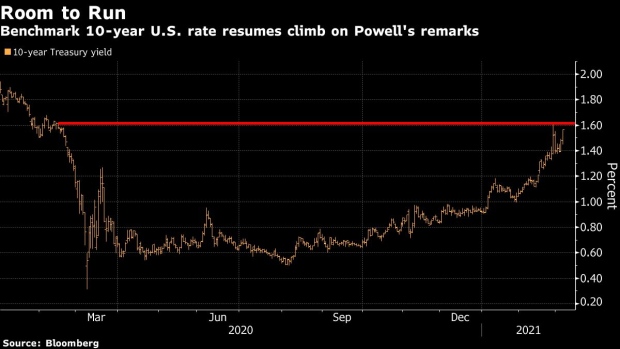(Bloomberg) -- Traders in the $21 trillion U.S. Treasury market are sending a clear signal that they intend to keep pushing yields higher until they upend financial conditions sufficiently to spark action from the Federal Reserve.
Ten-year yields climbed again on Friday, heading toward last week’s one-year high and undermining stocks, after Fed Chair Jerome Powell gave just a minor nod to the recent, abrupt surge in long-term borrowing costs. He stressed that officials are focused on the long road ahead before they achieve their policy goals.
Even before Powell spoke, some strategists were predicting the global borrowing benchmark rate was on course to reach 2%, a mere 40 basis points above last week’s peak. With yields on the rise again, it may not be long before mortgage-related hedging kicks in and brings that target closer. Goldman Sachs Group Inc. boosted its year-end forecast for 10-year Treasury yields on Thursday to 1.90% from 1.50%.
Friday’s February payrolls report now looms as the next catalyst. Yields have already soared more than a half-point this year as a cheerier outlook for growth and inflation led traders to bring forward how soon they see the Fed lifting its policy rate. Many strategists had expected Powell to try to more forcefully tamp down yields before the Fed’s black-out period ahead of its March 17 policy decision. With no such effort emerging, market participants are left to ponder where policy makers’ pain threshold may be.
“In this environment yields can certainly continue to test higher,” said Jonathan Cohn, a strategist at Credit Suisse. “How far the Fed is willing to allow stock markets to fall -- which is the poor man’s version of thinking about broad financial conditions -- is a key question.”
During an appearance in a Wall Street Journal webinar Thursday, Powell said the recent bond-market swings “caught my attention.” He said he’s monitoring financial conditions and would be “concerned by disorderly conditions in markets.”
Ten-year yields added 8 basis points on the day to 1.56%, and continued to creep higher in Asia hours touching 1.58%, bringing into view last week’s one-year high of 1.61%. With yields at current levels, there have been fresh concerns of convexity-related hedging flow which can undermine liquidity conditions and further roil riskier assets. Stocks slumped Thursday, with the S&P 500 Index briefly erasing its 2021 gains.
Powell said he’d be concerned if there were a “persistent tightening in financial conditions that threatens the achievement of our goals.” But he didn’t mention any actions the Fed might take to curtail the climb in yields, which has lifted mortgage rates and risks dimming a bright spot in an economy still on the mend from the pandemic.
Wall Street strategists have mulled options the Fed could take to push down long-term yields including: extending the duration of its bond purchases, or implementing a so-called “twist” operation -- involving selling part of the Fed’s shorter-dated holdings in favor of long-term Treasuries.
“If yields continue higher too quickly, then that could be a problem for the Fed,” said Mark Zandi, chief economist at Moody’s Analytics. “It might undermine asset prices, possibly causing a major correction in stock prices and a freezing up of the housing market. This is not our base case, but it’s a concern and a risk.”
Meanwhile, a market proxy for the anticipated annual inflation rate for the next half-decade exceeded 2.5% this week for the first time since 2008 -- aided by climbing oil prices.
Traders are now pricing in a full quarter-point Fed rate boost in the first quarter of 2023. The Fed itself has signaled it intends to keep policy steady at least through the end of that year.
”Market participants are putting the Fed to the test and saying, ‘OK, given this spike in inflation, if it’s not transient then you’re going to have to act sooner,”’ Scott Minerd, global chief investment officer of Guggenheim Partners, said in a Bloomberg Television interview.
(Updates with Friday’s yield move)
©2021 Bloomberg L.P.



